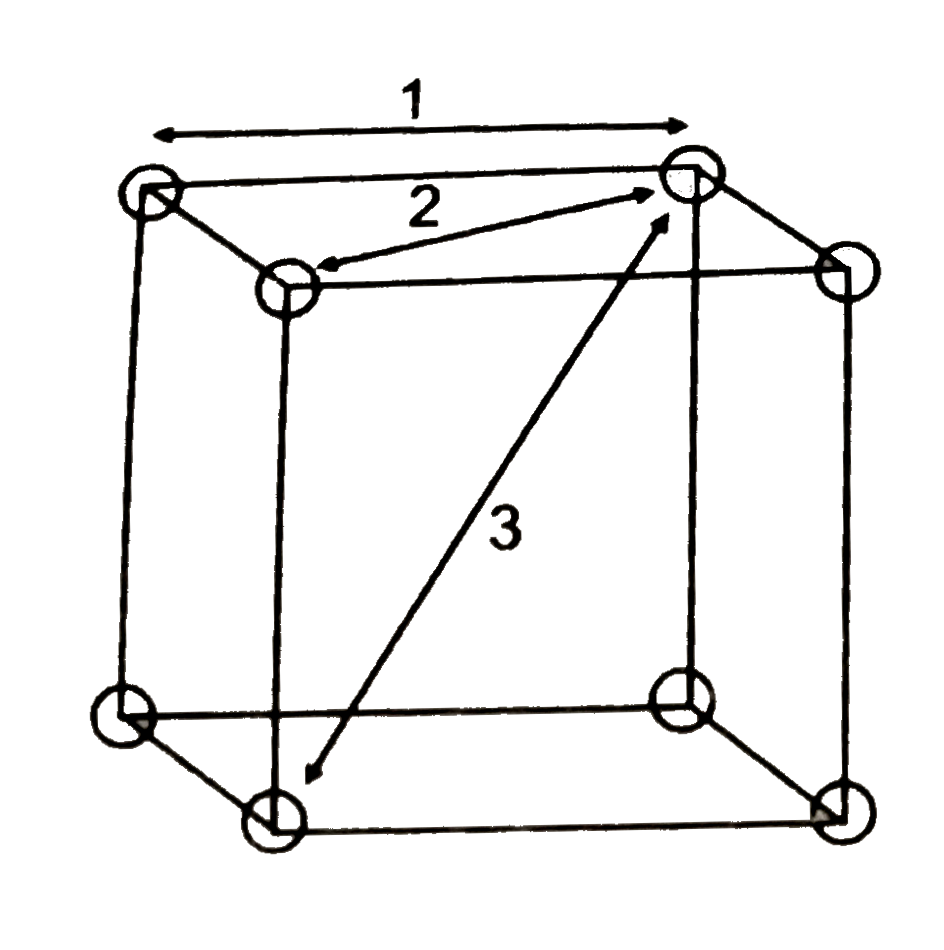First three nearest neighboure distance for primitive cubic lattice are respectively (edge length of unit cell = a):
l,√2l,√3l
√3l,√2,l
l,√2l,2l
l,√2l,l
The correct Answer is:A

(1) →l (First nearest neighbout distance)
(2) →l√2 (Second nearest neighbour distance)
(3) →l√3 (Third nearest neighbour distance)
Topper's Solved these Questions
- BOOK - OP TANDONCHAPTER - STATES OF MATTER (SOLID STATE)EXERCISE - Practice Problems20videos
STATES OF MATTER (SOLID STATE)
- BOOK - OP TANDONCHAPTER - STATES OF MATTER (SOLID STATE)EXERCISE - OBJECTIVE QUESTIONS (LEVEL -A)77videos
STATES OF MATTER (SOLID STATE)
- BOOK - OP TANDONCHAPTER - STATES OF MATTER (SOLID STATE)EXERCISE - SELF ASSESSMENT Section VI3videos
STATES OF MATTER (SOLID STATE)
- BOOK - OP TANDONCHAPTER - STATES OF MATTER (GASES AND LIQUIDS)EXERCISE - Self Assess,ent28videos
STATES OF MATTER (GASES AND LIQUIDS)
- BOOK - OP TANDONCHAPTER - THE COLLOIDAL STATEEXERCISE - Self Assessment21videos
THE COLLOIDAL STATE
Similar Questions
Potassium crystallizes in bcc unit cell with distance nearest neighbours of 4.52 Å, if its atomic mass = 39 amu.
(a)What would be edge length of unit cell ?
(b)What would be the density of K metal ?
(c ) How many nearest neighbouring atoms does each potassium atom has ?View SolutionConsider an element A. It crystallizes in double fcc (like diamond) with edge length x. If distance between nearest neighbours, and most distant neighbours in one unit cell is p,q and respectively then find :4p×rq2
View Solution
Knowledge Check
- Question 1 - Select One
First three nearest neighboure distance for primitive cubic lattice are respectively (edge length of unit cell = a):
Aa,√2a,√3aB√3a,√2a,aCa,√2a,2aDa,√3a,2a - Question 2 - Select One
First three nearest neighbour distance for body centred cubic lattice are respectively:
Aa√2,a,a√3Ba√2,a,a√3Ca√32,a,a√2Da√32,a,a√3 - Question 3 - Select One
First three nearestneighbour distances for body centered cubic lattice are respectively :
A√2a,a,√3aBa√2,a,√3aC√3a2,a,√2D√3a2,a,√3a
If number of nearest neighbours, next nearest (2nd nearest) neighbour and next to next nearest (3rd nearest) neighbours are x,y and z respectively for body centered cubic unit cell, then calculate value of xyz.
View SolutionMatch the type of unit cell given in Column I with the features given in Column II.
coloumn I
(i) primitive cubic unit cell
(ii) Body centred cubic unit cell
(iii) Face centred cubic unit cell
(iV) End centred orthohomic unit cell
Column -II
(a) Each of the three perpendicular edges compulsorily have the different edge length i.e., a≠ec
(b) Number of atoms per unit cell is one
(c) Each of the three perpendicular edges compulsorily have the same edge length i.e., a=b=c
(d) In additions to the contribution from the corner atoms the number of atoms present in a unit cell is three.View SolutionFirst three nearest neighbout distance for body centrered cubic lattice are
View SolutionHow is simple cubic unit cell formed ? Calculate the number of atoms in a simple unit cell.
View SolutionIn the primitive cubic unit cell, the atoms are present at the:
View Solution

